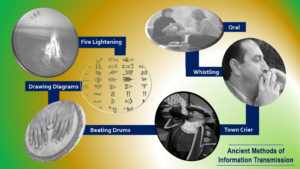Back to: Computer Studies JSS1
Welcome to class!
In today’s class, we shall be talking about town crying and whistling as an ancient method of transmitting information. Please enjoy the class!
Ancient Methods of Transmitting Information – town crying and whistling

In the age of lightning-fast internet and instant messaging, it’s easy to forget the ingenuity and resourcefulness of our ancestors. Before the digital revolution, information transmission relied on human ingenuity and a keen understanding of the environment. Today, we delve into two fascinating methods: town crying and whistling, exploring their unique characteristics and historical significance.
Town Crier: The Voice of Authority

Imagine a bustling town square. A man, adorned in distinctive attire, raises a bronze gong and strikes it with a resounding clang. This is the town crier, a figure of authority and information dissemination. His booming voice cuts through the air, announcing vital news, decrees, and pronouncements.
Town criers relied on their vocal prowess and persuasive delivery to captivate the audience. They employed various techniques like rhythmic chanting, intonation, and even theatrical gestures to ensure their message resonated with the listeners.
The town crier wasn’t just a newsreader. He was often entrusted with public duties like enforcing laws, conducting auctions, and even serving as a moral compass for the community.
While the official role of the town crier has largely faded, echoes of their legacy remain. Public address systems and announcements draw inspiration from this historical practice.
Whistling: A Symphony of Communication

While town cries relied on the spoken word, whistling offered an alternative, often coded, method of communication. Using complex patterns and variations in pitch and duration, communities conveyed messages across vast distances.
Whistling languages, like Silbo Gomero of the Canary Islands, were sophisticated systems with dedicated vocabularies. Shepherds used these codes to communicate over long distances and across rugged terrain.
Whistling wasn’t just for practical communication. It also served as a form of artistic expression and entertainment. Whistling competitions and musical performances showcased the skill and creativity of individuals.
Today, whistling languages are experiencing a revival. UNESCO recognizes their cultural significance, and efforts are underway to preserve these unique forms of communication.
Comparing and Contrasting
Both town crying and whistling represent ingenious methods of information transmission, each with its strengths and limitations.
Town Cries:
Strengths: Clear and concise delivery, suitable for large audiences, authoritative voice carries weight.
Limitations: Limited range, dependent on the town crier’s voice and presence, susceptible to environmental noise.
Whistling:
Strengths: Long-distance communication, coded messages for privacy, artistic expression.
Limitations: Complex codes require training and understanding, susceptible to misinterpretation, limited vocabulary.
While technology has revolutionized information transmission, the spirit of ingenuity and resourcefulness exemplified by town criers and whistlers remain relevant. Their legacy reminds us of the human desire to connect and share information, regardless of the tools available.
By understanding the rich history of town crying and whistling, we gain a deeper appreciation for human ingenuity and the enduring spirit of communication.
We have come to the end of today’s class. I hope you enjoyed the class!
In the next class, we shall be discussing drawing diagrams and making representations as an ancient method of transmitting information.
In case you require further assistance or have any questions, feel free to ask in the comment section below, and trust us to respond as soon as possible. Cheers!
Question Time:
- What are the advantages and disadvantages of relying on oral communication for information dissemination?
- How can we preserve and promote traditional methods of communication in the digital age?
- Can you imagine future technologies that are inspired by ancient communication methods?
